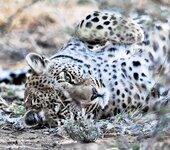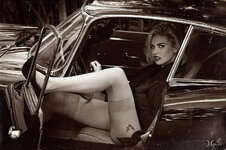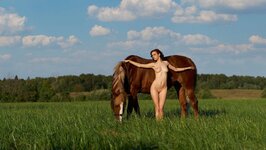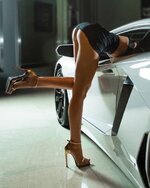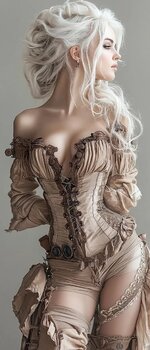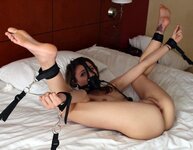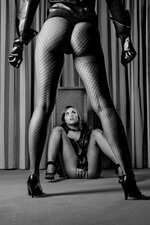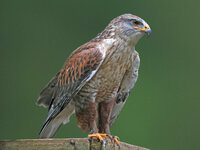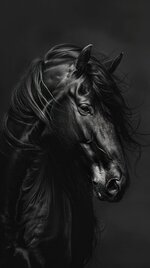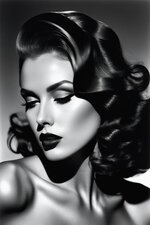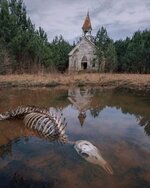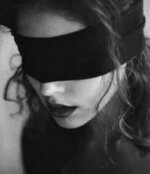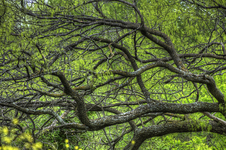Picture/Clip Post Magazine (New Joiners Read 1st post)
- Thread starter Pretty_Vixen
- Start date
OwnThatKinkGirl
Citizen of Zooville
Weeeellll, it's almost that simple. I've had problems where many times the camera simply can't capture what the eye sees. Doing a fair amount of photography in Southern Africa, unless you set your camera up to lower the exposure, the sun is so strong there that just about every clear day shot will appear overexposed. There also are cases where to photograph someone who has a much better tan installed at the factory than I do, even with the pro Nikon and Canon equipment, you simply have to shoot in 12 bit and adjust the contrast curves or black people's faces will get too dark around the sides of nose and lose the contrast that defines a face and makes a face a face. I can post some photos that show this.I am an avid fan of Myster and his photographs. He is a photographer of some note and I can assure you, these are photographs, not photoshops!
Also, what most people don't know is that back when film was a thing, each manufacturer had film tinted to make the skin of the people where it was sold to look healthier. Film I bought in Japan actually had a yellow tint to it to give people a healthier looking appearance. When I used it back in the US, there was an odd yellow tint covering everything. Who knew?
I've also taken photos of the Southern African sky while driving into a rainstorm where the clouds are purple and orange as lightning flashes, and then there are special morning greens you can see sometimes. In both cases, shooting at 12 bit color, that's 12 bits each for red, green and blue, those colors just didn't come through. I had to selectively bring up some shades so I could see what I saw - and it still wasn't enough.
I guess I'm trying to say that the camera doesn't always take the photo that you are seeing with your own eyes.
But there are actions in Photoshop that clearly alter images beyond what was seen. Even the cameras themselves come with lighting presets to attempt to approximate the lighting conditions that the photo was taken under and compensate. And even with the pro equipment, I still have to adjust most of my images to 1) get an image that was what I saw and 2) fix the image that I saw so that other people want to look at it.
Really. In midday, the sun is that butal. Texas is still hotter, but that sun means business.
Also, the sun is BRUTAL in parts of the south of Africa. But it plays an amazing role in the animal's lives. You just can't see a lion or lioness sitting in dried grass. You can be looking straight at it and still not see them. To show off the lions I photographed, I had to use Photoshop to make them stand out just a little from the surrounding grass so that people could see that "Yup, there are lions here. Oh, and there's another one. What, another one? How many lions are there here?" What I mean by that is that they blend in so well that it's easy to see how any prey could miss a 300 lb 6 foot plus lion stalking them.
Anyway. Fun conversation. I love talking about stuff like this because I had my own preconceptions about something as simple as taking photographs and then reality taught me otherwise. Just sharing what I learned.
Last edited:
Little Miss Humpee
Tourist
hat I mean by that is that they blend in so well that it's easy to see how any prey could miss a 300 lb 6 foot plus lion stalking them.
Anyway. Fun conversation. I love talking about stuff like this because I had my own preconceptions about something as simple as taking photographs and then reality taught me otherwise. Just sharing what I learned.
That was really interesting to read and a lot new stuff to learn.
Growing up with smartphones I feel like I am missing out on the true beauty of photography.
In the big picture not directly as a response to your message but about the thread in general I would say this thread is about positivity and most of us post what we love and if others love it as well, perfect.
If not, i think negative response doesn't belong here. I don't think there should be "eews" here or "that shit looks photoshopped" unless its against what Vixen imagined to be here or if its against forum rules of course.
Me, personally i am grateful for the awesome things posted here, and if I'm not like "wow" I am usually still like "hmm interesting".
It became my favorite thing to look here first and check what's been posted before i post mine
Last edited:
OwnThatKinkGirl
Citizen of Zooville
I agree. This thread is glorious. Hopefully, some of my photos will be able to add to the variety and be of the quality we'd all like to see. fingers crossed.1200 pages. Ain't that impressive? A big thank you again to @Pretty_Vixen for creating this.
With many of them, I'm posting images that are about 2560 pixels wide so if you want to see the glint in a leopard's eye zoom in. And since I have the originals, I can post photos up to 8200 x 5500 pixels (upload file size permitting). Just let me know if any photo stands out and you'd like photos larger than 2560 x 1707 or if that's good enough.
humananimal
Esteemed Citizen of ZV
Yes - it is a big and known problem among photographers that it is more difficult to take good pictures of vera dark / black people, well black panters too. Because most digital camera used can‘t show the contrast from bright to dark in same degree as our eyes can. It is becoming better and as written with a higher contrast resolution, now 10 bits, but I can see you know of systems with 12 bit, that should make it much better - if shown on a compatible screen.Weeeellll, it's almost that simple. I've had problems where many times the camera simply can't capture what the eye sees. Doing a fair amount of photography in Southern Africa, unless you set your camera up to lower the exposure, the sun is so strong there that just about every clear day shot will appear overexposed. There also are cases where to photograph someone who has a much better tan installed at the factory than I do, even with the pro Nikon and Canon equipment, you simply have to shoot in 12 bit and adjust the contrast curves or black people's faces will get too dark around the sides of nose and lose the contrast that defines a face and makes a face a face. I can post some photos that show this.
Also, what most people don't know is that back when film was a thing, each manufacturer had film tinted to make the skin of the people where it was sold to look healthier. Film I bought in Japan actually had a yellow tint to it to give people a healthier looking appearance. When I used it back in the US, there was an odd yellow tint covering everything. Who knew?
I've also taken photos of the Southern African sky while driving into a rainstorm where the clouds are purple and orange as lightning flashes, and then they are special morning greens you can see sometimes. In both cases, shooting at 12 bit color, that's 12 bits each for red, green and blue, those colors just didn't come through. I had to selectively bring up some shades so I could see what I saw - and it still wasn't enough.
I guess I'm trying to say that the camera doesn't always take the photo that you are seeing with your own eyes.
But there are actions in Photoshop that clearly alter images beyond what was seen. Even the cameras themselves come with lighting presets to attempt to approximate the lighting conditions that the photo was taken under and compensate. And even with the pro equipment, I still have to adjust most of my images to 1) get an image that was what I saw and 2) fix the image that I saw so that other people want to look at it.
Really. In midday, the sun is that butal. Texas is still hotter, but that sun means business.
Also, the sun is BRUTAL in parts of the south of Africa. But it plays an amazing role in the animal's lives. You just can't see a lion or lioness sitting in dried grass. You can be looking straight at it and still not see them. To show off the lions I photographed, I had to use Photoshop to make them stand out just a little from the surrounding grass so that people could see that "Yup, there are lions here. Oh, and there's another one. What, another one? How many lions are there here?" What I mean by that is that they blend in so well that it's easy to see how any prey could miss a 300 lb 6 foot plus lion stalking them.
Anyway. Fun conversation. I love talking about stuff like this because I had my own preconceptions about something as simple as taking photographs and then reality taught me otherwise. Just sharing what I learned.
So unless the surroundings are dark too, you can‘t show the differences in shade in a dark face and at the same time show the surroundings.
I guess that is why face-recognition system makes many mistakes when it is dark / black people.
Some argues that these systems are ‘racistic’. No it is simple photo technic.
And it seems they haven’t solved the problem yet.
Some digital cameras / mobile phones can activate a function where 3 consecutive photos is exposed different and they are then combined to one photo.
Last edited:
saddlebum66
Supreme Citizen of ZV
You guys might consider a thread for the Jargoneering and other assorted trayf and tschotke and let this be the thread its supposed to be....
Miss_Rachel
Zooville Settler
I will say this: My wife is a pretty good photographer, she has tried to explain several things to me. I understand "lossless" and a thing called HDR (?) and she has explained that she doesn't take JPEG pictures. Her cameras will take five images and overlay them and the results are quite stunning. Look, I don't really understand what I am trying to talk about, but she says you have to process almost every picture you take with a digital camera just like you must have done with film cameras.
This is supposed to be a gallery, so I'll shut up now. Let's all just enjoy it.
This is supposed to be a gallery, so I'll shut up now. Let's all just enjoy it.
Miss_Rachel
Zooville Settler
Miss_Rachel
Zooville Settler
Miss_Rachel
Zooville Settler
Miss_Rachel
Zooville Settler
Miss_Rachel
Zooville Settler
Miss_Rachel
Zooville Settler
Miss_Rachel
Zooville Settler
Miss_Rachel
Zooville Settler
Miss_Rachel
Zooville Settler
Miss_Rachel
Zooville Settler
Miss_Rachel
Zooville Settler
saddlebum66
Supreme Citizen of ZV
a Beaut, this one
Little Miss Humpee
Tourist
Little Miss Humpee
Tourist
Little Miss Humpee
Tourist
Little Miss Humpee
Tourist
Little Miss Humpee
Tourist
Little Miss Humpee
Tourist
Little Miss Humpee
Tourist
And that's it for today, TGIF , the weekend is near 
Very very sexy imoSenior she is, but this End is not without her CharmsView attachment 662762
BergDry
Esteemed Citizen of ZV
@saddlebum66
@Miss_Rachel
@Pretty_Vixen
@Kristy
& last but not least
@Little Miss Humpee
OwnThatKinkGirl
Citizen of Zooville
WARNING: JARGON ALERT. Danger, Will Robinson! Danger! Danger!I will say this: My wife is a pretty good photographer, she has tried to explain several things to me. I understand "lossless" and a thing called HDR (?) and she has explained that she doesn't take JPEG pictures. Her cameras will take five images and overlay them and the results are quite stunning. Look, I don't really understand what I am trying to talk about, but she says you have to process almost every picture you take with a digital camera just like you must have done with film cameras.
This is supposed to be a gallery, so I'll shut up now. Let's all just enjoy it.
Lossless means that the data captured when the photo was taken is stored in a type of file and is the data you see. JPEGs are lossy compression - but what matters is if your eye cares about what is lost. With JPEG, you can compress to a higher level for a smaller file size and that eliminates some detail from the image. The greater the compression, the more is lost. Most cameras offer two forms of photo storage, the lossless RAW format and the lossy JPEG. Nikon's RAW are stored in NEF files. Canon uses CRW. Both are lossless. Generally, you can think of the RAW files as the masters where the data is EXACTLY as the camera captured it. Most cameras allow shooting to store the image in RAW or JPEG or both at the same time with varying detail levels for JPEG. As far as I know, the JPEG files are always 8 bit RGB images. Until the advent of billion color screens, this normally didn't matter too much unless you were photographing with the intent of having the images printed in a magazine or on your wall. In that case, you shot in RAW at 12 bir probably using a Leica, Hasselblad, Leaf Aptus or in medium format with a Mamiya or Fuji and processed the images after. When shooting in JPEG, what most cameras also do is to allow a little "bumping" of color values to make them pop a little more. This makes the JPEGs generally look better and be smaller than the RAW files with the least amount of effort.
What really sings though is when you're able to take the JPEG file compressed a little moderately to serve as a bit of a goal since the RAW files don't jump out as much being closer to reality. With the 12 bit files, there simply is more data to "do math with" and get really crisp images that are dramatic and better looking. I'd started to type up how braketing works yesterday in response to a reply to my other explanation but it really applies here. With these images that are 12 bits per pixel, it's more than you can see - on non billion color screens - but you can see the difference in print. With bracketing, you take 3, 5 or 7 photos in a burst. In the simplest case one photo is at a lower exposure, one is at the expected exposure and the other is at +1 exposure. These are all merged in a way that lets greater contrast and drama come through in that the math can take more extreme values from each photo. Generally, you'll have a 32 bit 50 or 100 MB image. Perfect for getting the most out of areas which need more contrast. And the HDR (short for high dynamic range) technique relies on this to apply color range treatments in a way that can be either astounding or garish. I've used this to get a few photos to what I wished the camera captured. It's also really easy to overdo but when it's done right it can make an image just feel meaty and raw or subtle, rich and beautiful. Hopefully two of mine I plan on posting will achieve the desired effect. Anyway, enough mansplaining for the time being. Back to the perty pitchers.


